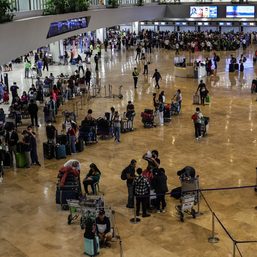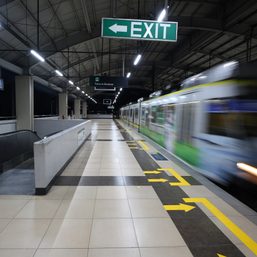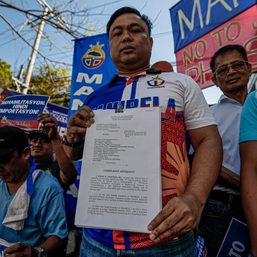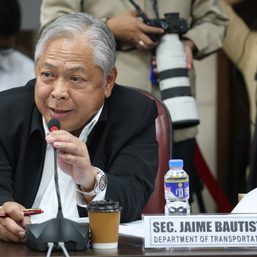SUMMARY
This is AI generated summarization, which may have errors. For context, always refer to the full article.
![[Vantage Point] The urgency of a NAIA facelift](https://www.rappler.com/tachyon/2023/06/TL-urgency-NAIA-facelift-June-9-2023.jpg)
The Ninoy Aquino International Airport (NAIA) would finally get a much-needed total makeover with its planned privatization finally taking off.
There had been attempts in the past to spruce up the airport, but nothing came out of it due to the underhanded efforts of some enterprising people in government who were scuttling the deal for whatever vested-interest motivation, succeeding in scaring off investors – notably a group of taipans – and unfortunately helped perpetuate the decades-old suffering of both local and international travelers.
On Wednesday, June 7, the Department of Transportation (DOTr) announced that Naia’s privatization could commence as early as the first quarter of next year. A lot would depend on the process of awarding the contract to the chosen concessionaire. Rappler learned that the DOTr is eyeing both the solicited and unsolicited routes in privatizing the airport, but it will entirely depend on which comes first.
The DOTr and the Manila International Airport Authority (MIAA) both submitted their joint plans to the National Economic and Development Authority (NEDA) on June 2.
DOTr seeks P141B commitment
In an interview, DOTr Secretary Jaime Bautista told Rappler that investors must commit P141 billion in investments, exclusive of a straight-up payment of P30 billion, annuity payments of P2 billion, and a share of NAIA’s total revenue – expected to reach billions – to be generated from its commercial and non-commercial operation.
Bautista said that, contrary to misconceptions, the NAIA is not being sold. The government is offering to the private sector the right to rehabilitate, manage, and operate the airport under a concession. Under the said privatization project, a private concessionaire will have 25 years to operate the airport and recover its investment.
DOTr’s move to consider the Public-Private Partnership (PPP) route, which the previous DOTr management shunned, is a good move. Former DOTr Secretary Arthur Tugade rationalized the junking of the PPP saying a negotiated deal between government to government is the faster course and a better option to facing delays that may emerge with public biddings concerning the private sector.
But for me, PPP is a more feasible contractual agreement between the Philippine government and a private firm targeted towards financing, designing, implementing, and operating infrastructure facilities and services that were traditionally provided by the public sector. It embodies optimal risk allocation between the parties because it minimizes cost while realizing project developmental objectives. The project will be structured in such a way that the private sector gets a reasonable rate of return on its investment.
PPP addresses the limited funding resources for local infrastructure or development projects of the public sector, thereby allowing the allocation of public funds for other local priorities. It is a mechanism to distribute project risks to both the public and private sectors. PPP ensures that both sectors will gain improved efficiency and project implementation processes in delivering services to the public. Most importantly, PPP emphasizes value for money by focusing on reduced costs, better risk allocation, faster implementation, improved services, and possible generation of additional revenue.
Under the Build-Operate-Transfer (BOT) scheme which this project is going to be implemented, the government spends nothing. The concessionaire puts up the funding, builds the airport, gets paid by operating it for 25 years before turning the project over to the government.
Without doubt, our country needs more than two airports. Most of the major cities today have two, even three or more, major airports actively servicing their citizens. Serving 42 million passengers a year, the Naia reels from deterioration. Its four passenger terminals simply could not cope, dismally serving just over 40 percent of its designed passenger traffic capacity. Through the years, only one domestic and three international terminals have been built at the NAIA, with the frequency of plane arrivals and departures at only 40 an hour.
The privatization of state-owned airports has gone global. The French government, for example, first turned over management of its airports to local authorities, and now to private entities. In Japan, 30- to 40-year concessions to run some of its airports are being sold by the government.
By offering a wide range of income sources, airports present a better risk profile to the private sector than other major infrastructure investments, These income sources include landing fees, airline contracts, and other aviation-specific sales, as well as retail, shopping and hotels.
Not surprisingly, as shown by the level of interest in the NAIA rehabilitation bid and the continually growing demand for aviation, local conglomerates see airport operations as a good business investment. Although NAIA’s upgrade would entail a huge initial investment, profitability prospects in the long term are promising.
Not only is the private sector more equipped to plan long-term for more efficient operations and maintenance of the airport’s four terminals, company owners and executives look at a 20- to even a 50-year horizon, compared with government appointees’ short terms.
NAIA needs a long-term, lasting solution now!
Yes, NAIA’s location is central. True, it has the required supporting infrastructure. But to be the country’s world-class gateway to the world, NAIA needs the kind of connected aviation ecosystem that seamlessly links together airlines, airports, air traffic management, and support services with the millions of passengers who pass through its gates every month, enhancing air travel experience with flawless and sustainable airport operations.
For more than two decades now, NAIA has been ripe for rehabilitation. Just consider the numerous proposals for the airport’s upgrade that the government has received through the years from various private sector groups. Now is not the time to gamble on uncertain and untested novice airport projects which have no supporting infrastructure.
The glitch that temporarily paralyzed airport operations early this year has resulted in even more strident cries to upgrade this antiquated and congested infrastructure that we call our international gateway. Quick fixes and short-term solutions are not the answer. The time has come for concrete, sweeping, and optimal reforms to bring NAIA to the 21st century. The taxpaying public and air travellers need to know how and when the NAIA will be modernized. The country cannot afford to wait for pedestrian airport projects that will take forever to build.
The DOTr has received an unsolicited but welcome proposal from the Manila International Airport Consortium (MIAC), which includes units of listed conglomerates Aboitiz InfraCapital, Inc., AC Infrastructure Holdings Corporation, Asia’s Emerging Dragon Corporation, Alliance Global – Infracorp Development, Inc., Filinvest Development Corporation, and JG Summit Infrastructure Holdings Corporation. Joining the Consortium is U.S.-based Global Infrastructure Partners, a global giant which has interests in airports across London and Sydney.
What differentiates the government’s solicited proposal and the MIAC proposal?
The government’s solicited proposal is asking for a P141 billion project cost commitment from potential bidders and includes a P30 billion upfront payment, P2 billion annuity payment, and a share of total revenue in its terms.
MIAC is offering a turnkey proposal. All the upfront investments, project management expertise, and operational knowhow will be put up by the Consortium, with a hefty US$ 1 billion concession payment and projected direct and indirect economic value upwards of US$ 14 billion throughout a 25-year concession period.
Obviously, MIAC’s proposal is complete and ready to take off, presenting the fastest track ever to the complete modernization of the NAIA, aimed at benefiting travelers and at the same time giving revenue-generating opportunities to the Philippine government. Rather than waste more months and possibly years waiting for other solicited proposals to be prepared, launched, and executed, MIAC’s unsolicited proposal is timely and readily viable.
Longer concession period is required
For an undertaking as monumental as the NAIA rehabilitation, anything shorter than the 25-year concession will lose the project’s appeal to investors. All parties involved would need a longer time horizon to establish new operational efficiencies that would elevate the airport to global standards and enable them to recoup their significant investments.
The concession period specified by the Consortium appears to be the most sustainable to realize NAIA’s full potential. Currently, the airport has a capacity of 31 million passengers per annum. Through its investment, MIAC would be able to serve up to 62.5 million passengers per annum in five years and accommodate up to 70 million passengers per annum by 2048.
While our national pride in it may have been tarnished by the past few decades’ infamous operational mishaps and management missteps, NAIA undeniably continues to play a central role in the country’s economic growth. It’s time for NAIA to fly higher and more proudly than ever before! – Rappler.com
Val A. Villanueva is a veteran business journalist. He was a former business editor of the Philippine Star and the Gokongwei-owned Manila Times. For comments, suggestions email him at mvala.v@gmail.com.
Add a comment
How does this make you feel?
![[Vantage Point] Are airport glitches avoidable?](https://www.rappler.com/tachyon/2023/02/airport-glitches.jpg?fit=449%2C449)







![[Under 3 Minutes] When will we see modern jeepneys on the road?](https://www.rappler.com/tachyon/2024/04/francisco-motors-modern-jeepney-prototype-1.jpg?resize=257%2C257&crop=590px%2C0px%2C1012px%2C1012px)




![[Vantage Point] BDO lifts NAIA rehab](https://www.rappler.com/tachyon/2024/02/tl-naia-bdo-smc.jpg?resize=257%2C257&crop=370px%2C0px%2C1080px%2C1080px)

![[VANTAGE POINT] MIAA on the spotlight: Follies of the law](https://www.rappler.com/tachyon/2023/09/martires-miaa-september-5-2023.jpg?resize=257%2C257&crop=328px%2C0px%2C1080px%2C1080px)





There are no comments yet. Add your comment to start the conversation.